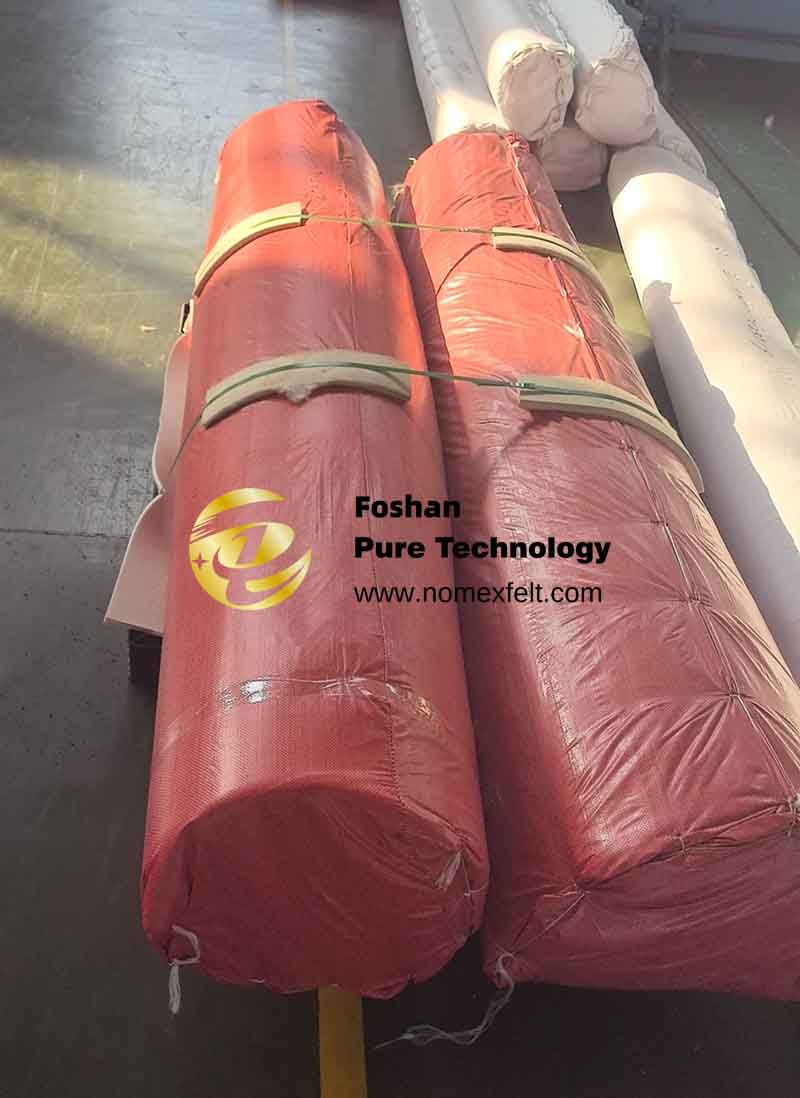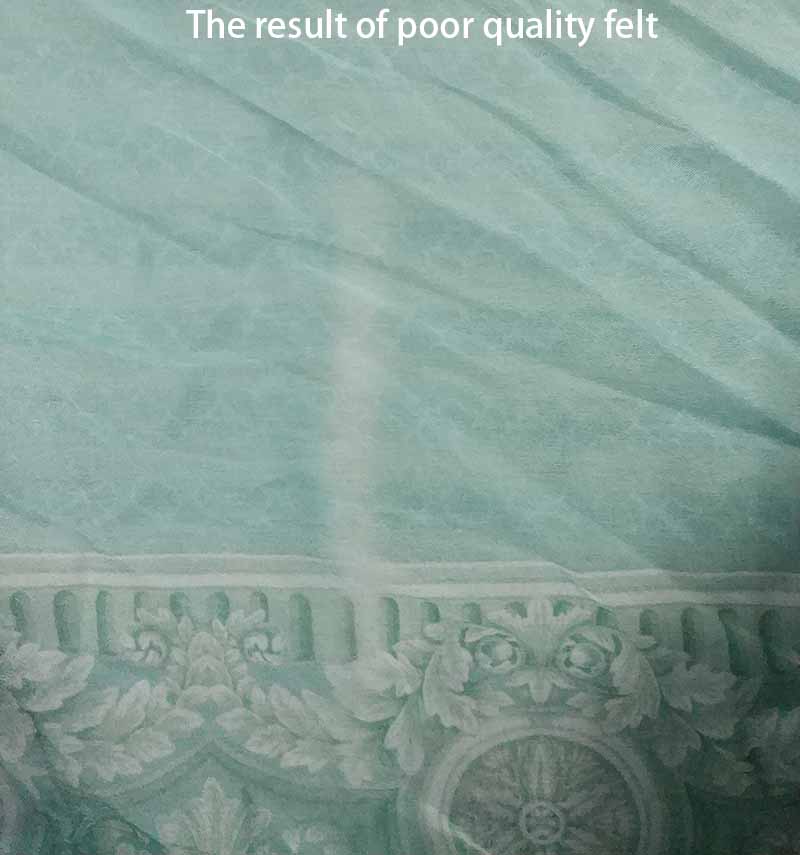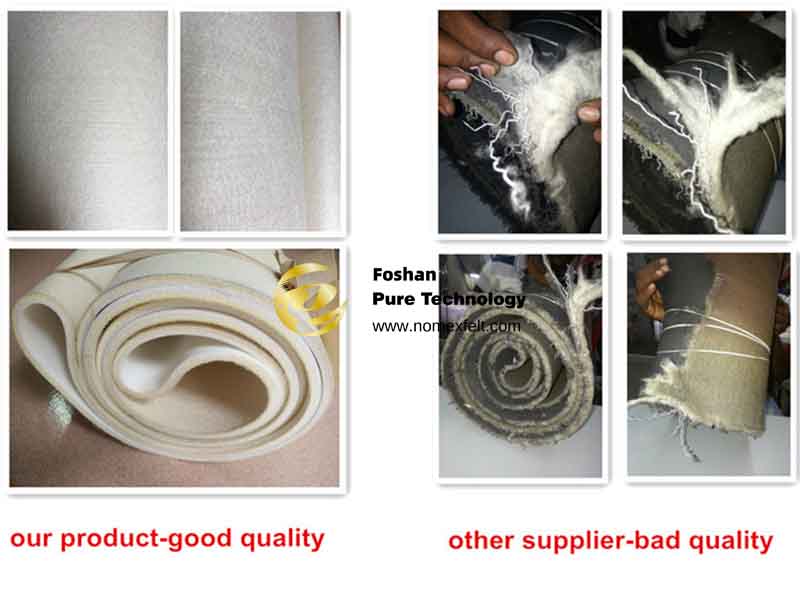Heat transfer felt is made of Nomex fiber, which has good high-temperature and wear resistance. Heat transfer felt is also called heat-resistant roller cover, finishing machine felt, or high-temperature seamless blanket.
It is widely used in heat transfer printing fabrics such as leather, curtains, clothing, ribbons, and other textiles, It is an important material in the heat transfer printing process. If you want to extend its service life, please follow the following guidelines to ensure its best performance.
When removing the packaging, avoid touching the surface of the heat transfer felt with sharp tools to prevent damage. After removing the packaging, put on gloves and carefully move the felt to remove the PVC packaging film.
After opening the package, find the part with the serial number and arrow mark and place it next to the machine or the removed roller to ensure the correct direction after installation and avoid bumping with other parts of the equipment and damaging the surface of the felt.

The following are recommended felt operation rules:
|
Speed status |
Temperature (Celsius) |
Operating time (hours) |
|
Low speed in sequence |
140 | 2 |
| 170 | 2 | |
| 200 | 4 | |
|
High speed in sequence |
220 | 2 |
| 240 | 2 |
Finally, lower the temperature to 220°C and run the machine. Check whether the tension of the heat transfer felt is uniform. During the shaping process, the cylinder pressure of the pressure roller is set between 3 and 4 bars. Heat transfer felt tension does not need to be too large. It can be adjusted to the point where can rotate.
If the heat transfer felt deviates slightly, it should be reversed after the cylinder is lifted. The deviation should be adjusted after shaping. To maintain its stability, do not loosen the thought within a week. After the operation, the temperature should be lowered to below 100 degrees Celsius before the machine can be turned off.
Studies have shown that heat transfer felt can last 2-3 years if it is run 8 hours a day; running less than 8 hours a day can last 3-4 years; and if it works continuously for 24 hours a day, it may only last 1-2 years. Avoid letting the machine work continuously for a long time to prevent overheating and accelerated equipment wear. If continuous operation is unavoidable, replacing heat transfer felt regularly is recommended.
To remove dust from the heat transfer felt surface, gently wipe it with a soft brush. Gently brush along the texture direction of the felt to remove the dust. You can use a special cleaner with mild stains on the surface. Avoid using strong decontamination ingredients or bleaching agents, because these ingredients may damage the fiber structure of the heat transfer felt. Use a clean soft cloth to wipe it.
When wiping, pay attention to moderate force to avoid excessive force that may cause deformation or damage to the felt. For stubborn stains, you can use organic solvents for cleaning. For example, alcohol or special textile cleaners, first test a small area in an inconspicuous area to observe whether there is fading or damage. If there is no problem, gently wipe the stained area with a cotton ball, repeatedly until the stain is removed.
After that, you need to wipe the remaining organic solvent with a clean, damp cloth. If the organic solvent remains on the felt, it may have an adverse effect on the subsequent transfer process.
When not in use, it should be stored in a dry, cool place away from direct sunlight. Long-term sunlight exposure may cause the heat transfer blanket to age and fade, affecting its heat transfer performance. It should also be placed in a special storage place to prevent dust and other impurities from contaminating it.
During use, avoid heavy pressure and long-term folding. Heavy pressure will cause the fiber structure of the heat transfer felt to be destroyed, making it uneven and affecting the transfer effect. Long-term folding will cause creases in the folded parts, and these creases will cause defects in the transferred pattern.
Regularly check whether the surface of the heat transfer felt is worn or the fibers are falling off. If the surface is found to be damaged and a large area of fibers is falling off, a new thermal transfer felt should be replaced, because the damaged printed felt may cause problems such as uneven temperature and incomplete patterns during the transfer process, thus affecting product quality.

Good heat transfer felts usually use high-quality Nomex fibers. You can check the product description or consult the manufacturer to understand the material composition of the felt. If the felt contains more inferior fibers or is mixed with impurities, its quality is low and does not meet the requirements. For example, some will be made of recycled fibers, which contain many impurities and affect their performance.
In the heat transfer printing process, the higher the production density, the tighter the fiber arrangement of the felt, which can provide more attachment points for the heat transfer printing ink, allowing the ink to better penetrate the fiber interior, making the pattern color more vivid. Our production density is 400 g/㎡ /mm, thickness is 6mm-10 mm.

As a key material in the heat transfer process, it is very important to choose a good heat transfer printing felt blanket. We have a professional technical team. After users purchase products, we will provide detailed installation instructions. If you encounter any problems during use, we will quickly help users solve the problems and provide quality assurance for the heat transfer felt products provided. If you want to know more about heat transfer felt or have other needs, please feel free to contact us.
As we know, Heat Transfer Printing Felt is suitable for fabrics, decorative fabrics, curtains, le...
Read Safety Rules for Laundry Management to be a qualified manager. PARTⅠ Laundry room Safety Gen...
The extrusion machine is the leading equipment for the production of aluminum profiles. The quali...
Heat transfer printing is a contemporary printing process in the clothing market. It prints the p...
In the textile industry, felt is only a small part but important. About how to choose felt that i...
Foshan Pure Technology Company., Ltd. helps conveyor belt manufacturers source equipment to metal...
Nomex, an intermediate aramid, also known as aramid 1313. It is characterized by good heat resist...
In the 1960s, the Dupont developed a kind of aramid composite material, it is Kevlar. It has very...